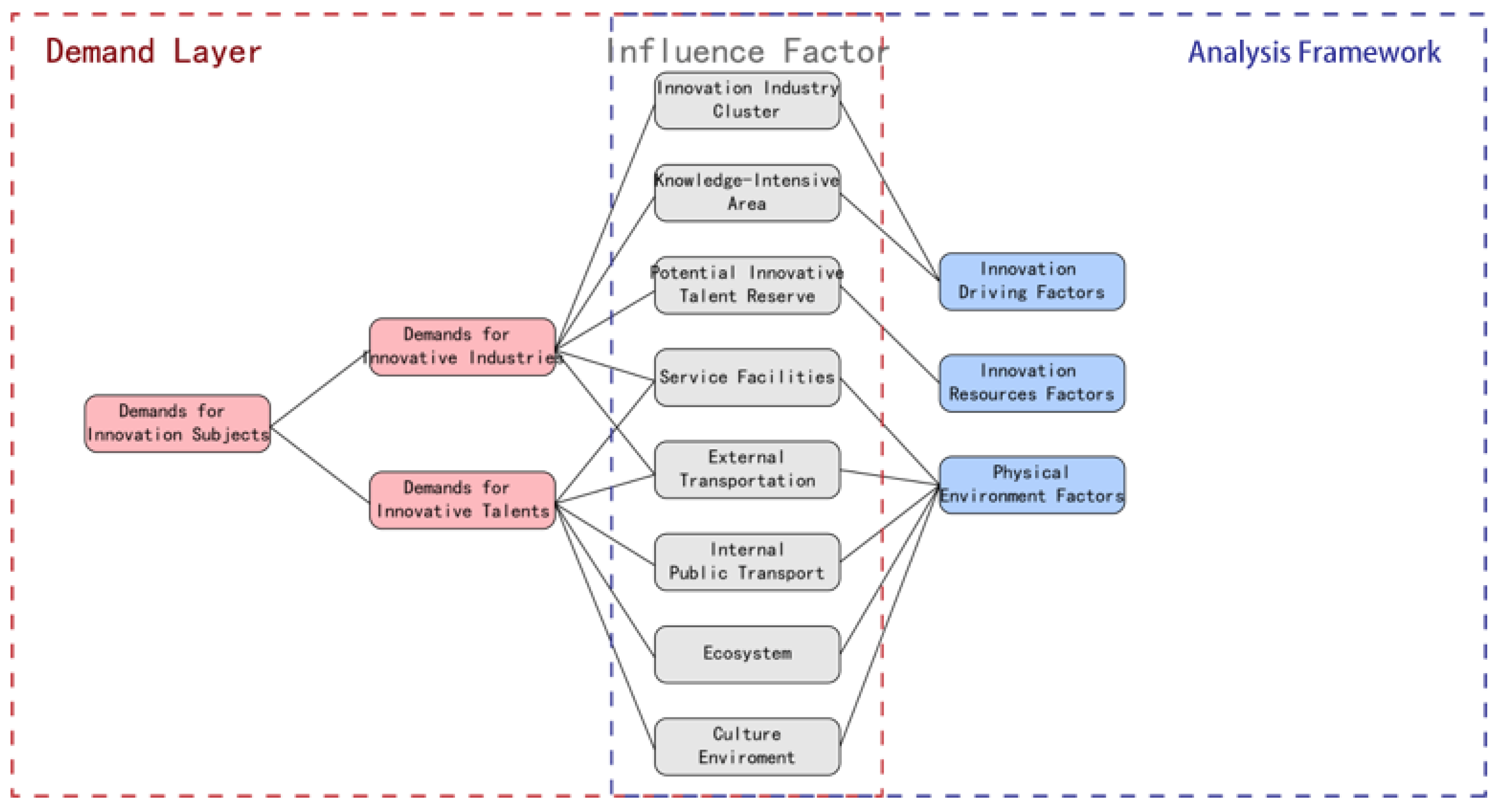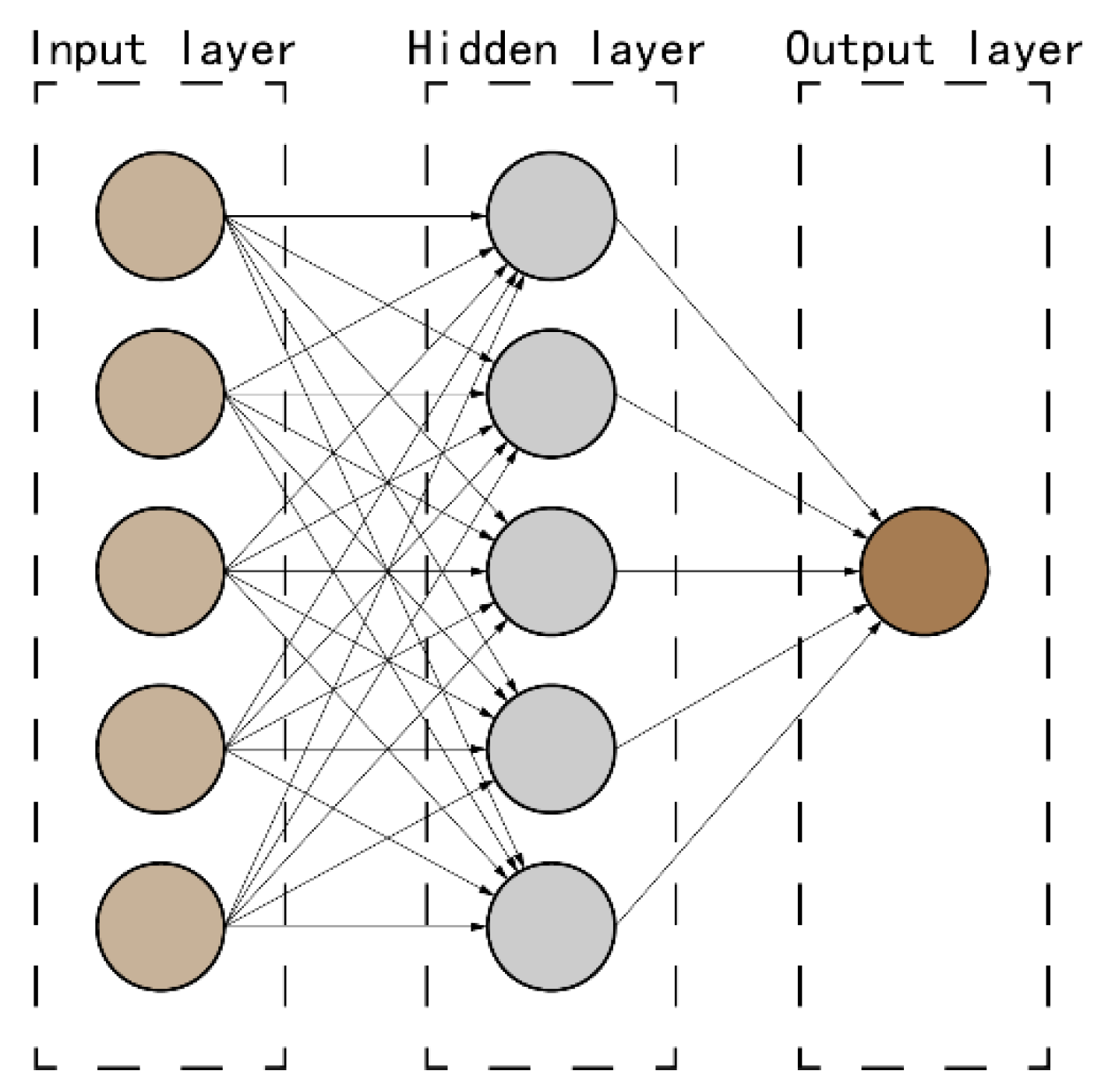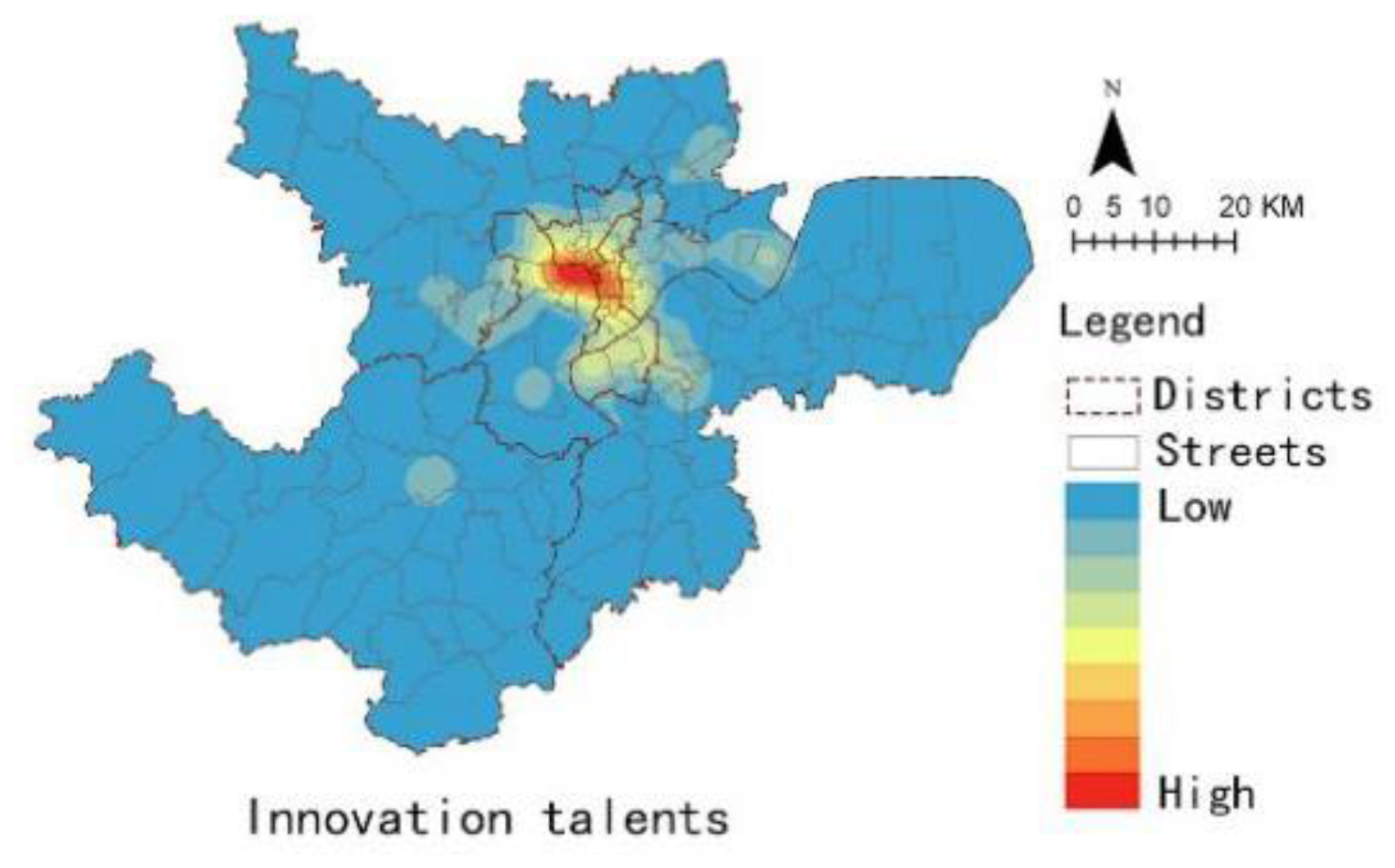Influence Factors of Spatial Distribution of Urban Innovation Activities Based on Ensemble Learning: A Case Study in Hangzhou, China
Abstract
:1. Introduction
2. Literature Review
3. Influence Factors of the Spatial Distribution of Urban Innovation Activities
3.1. Demand Characteristics of Innovation Industries
3.2. Demand Characteristics of Innovation Talents
3.3. Analysis Framework of Influence Factors under Demand Orientation
4. Research Design, Data, and Methods
4.1. Research Design
4.2. Research Object
4.3. Data Collecting and Data Processing
4.3.1. Data Collecting
4.3.2. Data Processing
4.4. Research Method
4.4.1. Correlation Analysis Based on Pearson Coefficient
4.4.2. Construction of Interpretation Model Based on Ensemble Learning
4.4.3. Accuracy Detection Methods of Models
5. Research Results
5.1. Correlation Analysis of Influence Factors and Innovation Activities
5.2. Interpretation Model and Operation Results Based on Boosting
5.3. Analysis of the Influence Factors on Spatial Distribution of Innovation Activities
5.3.1. Innovation Driving Force
5.3.2. Innovation Resource
5.3.3. Innovation Environment
6. Conclusions and Limitation
6.1. Conclusions
6.2. Limitations
Author Contributions
Funding
Acknowledgments
Conflicts of Interest
References
- Feldman, M.P.; Audretsch, D.B. Innovation in cities: Science-based diversity, specialization and localized competition. Eur. Econ. Rev. 1999, 43, 409–429. [Google Scholar] [CrossRef]
- Ciccone, A. Agglomeration effects in Europe. Eur. Econ. Rev. 2002, 46, 213–227. [Google Scholar] [CrossRef] [Green Version]
- Packalen, M.; Bhattacharya, J. Cities and ideas. Natl. Bur. Econ. Res. 2015. [Google Scholar] [CrossRef]
- Florida, R.; Adler, P.; Mellander, C. The city as innovation machine. Reg. Stud. 2016, 51, 86–96. [Google Scholar] [CrossRef]
- Liu, N.N.; Wang, J.W.; Song, Y. Organization mechanisms and spatial characteristics of urban collaborative innovation networks: A case study in Hangzhou, China. Sustainability 2019, 11, 5988. [Google Scholar] [CrossRef] [Green Version]
- Schumpeter, J.A. The Theory of Economic Development, 16th ed.; Transaction Publishers: Piscataway, NJ, USA, 2012; pp. 72–87. [Google Scholar]
- He, S.H.; Du, D.B.; Jiao, M.Q.; Lin, Y. Spatial-temporal characteristics of urban innovation capability and impact factors analysis in China. Sci. Geogr. Sin. 2017, 37, 1014–1022. [Google Scholar]
- Du, Z.W.; Lv, L.C.; Huang, R. Spatial pattern of in-dustrial innovation efficiency for Chinese cities at prefecture level and above. Sci. Geogr. Sin. 2016, 36, 321–327. [Google Scholar]
- Duan, D.Z.; Du, D.B.; Liu, C.L. Spatio-temporal evolution of urban innovation structure based on zip code geodatabase: An empirical study from Shanghai and Beijing. J. Geogr. Sci. 2016, 26, 1707–1724. [Google Scholar] [CrossRef] [Green Version]
- Wang, R.F.; Weng, Y.C.; Zhou, Z.G.; Chen, L.Y.; Hao, H.X.; Wang, J. Multi-objective ensemble deep learning using electronic health records to predict outcomes after lung cancer radiotherapy. Phys. Med. Biol. 2019, 64, 245005. [Google Scholar] [CrossRef]
- Kadir, S.; Selami, B.; Muhammet, F.A. An ensemble learning estimation of the effect of magnetic coupling on switching frequency value in wireless power transfer system for electric vehicles. Sn Appl. Sci. 2019, 1, 1712. [Google Scholar]
- Morpurgo, R.; Mussi, S. An intelligent diagnostic support system. Expert Syst. 2001, 18, 43–58. [Google Scholar] [CrossRef]
- Feldman, M.P.; Florida, R. The geographic sources of innovation: Technological infrastructure and product innovation in the United States. Ann. Assoc. Am. Geogr. 1994, 84, 210–229. [Google Scholar] [CrossRef]
- Lim, U. The spatial distribution of innovative activity in US metropolitan areas: Evidence from patent data. J. Reg. Anal. Policy 2003, 33, 97–98. [Google Scholar]
- Xu, H.Y.; Hsu, W.L.; Lu, X.Y. Research on spatial characteristics and mechanisms of regional innovation capacity in Jiangsu Province, China. IEEE Int. Conf. Adv. Manuf. 2018, 81–84. [Google Scholar] [CrossRef]
- Méndez, R.; Moral, S.S. Spanish cities in the knowledge economy: Theoretical debates and empirical evidence. Eur. Urban Reg. Stud. 2011, 18, 136–155. [Google Scholar] [CrossRef]
- Halbert, L. Collaborative and collective: Reflexive co-ordination and the dynamics of open innovation in the digital industry clusters of the Paris region. Urban Stud. 2012, 49, 2357–2376. [Google Scholar] [CrossRef]
- Florida, R. The Rise of the Creative Class-Revisited: Revised and Expanded; Basic Books: New York, NY, USA, 2014. [Google Scholar]
- Teirlinck, P.; Spithoven, A. The spatial organization of innovation: Open innovation, external knowledge relations and urban Structure. Reg. Stud. 2008, 42, 689–704. [Google Scholar] [CrossRef]
- Ellison, G.; Glaeser, E.L. The geographic concentration of industry: Does natural advantage explain agglomeration? Am. Econ. Rev. 1999, 89, 311–316. [Google Scholar] [CrossRef] [Green Version]
- David, L.R. Technological relatedness and knowledge space: Entry and exit of US cities from patent classes. Reg. Stud. 2015, 49, 1922–1937. [Google Scholar]
- Acs, Z.J.; Anselin, L.; Varga, A. Patents and innovation counts as measures of regional production of new knowledge. Res. Policy 2002, 31, 1069–1085. [Google Scholar] [CrossRef]
- Jaffe, A.; Trajtenberg, M.; Henderson, R. Geographic localization of knowledge spillovers as evidenced by patent citations. Q. J. Econ. 1993, 108, 577–598. [Google Scholar] [CrossRef]
- Griliches, Z. Issues in assessing the contribution of research and development to productivity growth. Bell J. Econ. 1979, 10, 92–116. [Google Scholar] [CrossRef]
- Fischer, M.M.; Varga, A. Spatial knowledge spillovers and university research: Evidence from Austria. Ann. Reg. Sci. 2003, 37, 303–322. [Google Scholar] [CrossRef]
- Dietterich, T.G. Ensemble methods in machine learning. In Proceedings of the 1st International Workshop on Multiple Classifier Systems (MCS), Cagliari, Italy, 21–23 June 2000; pp. 1–15. [Google Scholar]
- Friedman, J.H. Greedy function approximation: A gradient boosting machine. Ann. Stat. 2001, 29, 1189–1232. [Google Scholar] [CrossRef]
- Breiman, L. Bagging predictors. Mach. Learn. 1996, 24, 123–140. [Google Scholar] [CrossRef] [Green Version]
- Schapire, R.E.; Freund, Y. Boosting: Foundations and Algorithms; MIT Press: Cambridge, MA, USA, 2012. [Google Scholar]
- Ancori, B. The economics of knowledge. Ind. Corp. Chang. 2000, 9, 255–287. [Google Scholar] [CrossRef]
- Boulding, K.E. The economics of knowledge in life and the knowledge of economics. Am. Econ. Rev. 1966, 56, 1–13. [Google Scholar]
- Wu, J.S. Knowledge Economics; Capital University of Economics and Trade Press: Beijing, China, 2007. [Google Scholar]
- Strange, W.; Hejazi, W.; Tang, J. The uncertain city: Competitive instability, skills, innovation and the strategy of agglomeration. J. Urban Econ. 2006, 59, 331–351. [Google Scholar] [CrossRef]
- Sun, Y.K.; Li, G.P.; Yuan, W.W.; Sun, T.S. The spatial concentration of innovation and its mechanisms: A literature review and prospect. Hum. Geogr. 2017, 32, 17–24. [Google Scholar]
- Berliant, M.; Reed, R.R.; Wang, P. Knowledge exchange, matching, and agglomeration. J. Urban Econ. 2006, 60, 69–95. [Google Scholar] [CrossRef] [Green Version]
- Koskinen, K.U.; Vanharanta, H. The role of tacit knowledge in innovation process of small technology companies. Int. J. Prod. Econ. 2002, 80, 57–64. [Google Scholar] [CrossRef]
- Audretsch, D.B.; Lehmann, E.E.; Warning, S. University spillovers and new firm location. Res. Policy 2005, 34, 1113–1122. [Google Scholar] [CrossRef] [Green Version]
- Swap, W.; Leonard, D.; Shield, M.; Abram, L. Using mentoring and storytelling to transfer knowledge in the workplace. J. Manag. Inf. Syst. 2011, 18, 95–114. [Google Scholar] [CrossRef]
- Wu, J.S. Research on the Factors affecting the location choice of high-tech industrial parks. Sci. Technol. Prog. Policy 2008, 3, 83–86. [Google Scholar]
- Almeida, P.; Kogut, B. Localization of knowledge and the mobility of engineers in regional networks. Manag. Sci. 1999, 45, 905–916. [Google Scholar] [CrossRef] [Green Version]
- Waldmann, P. On the use of the Pearson correlation coefficient for model evaluation in genome-wide prediction. Front. Genet. 2019, 10, 899. [Google Scholar] [CrossRef]
- Zhou, Z.H. Ensemble Methods: Foundations and Algorithms; Chapman & Hall/CRC: Boca Raton, FL, USA, 2012. [Google Scholar]
- Bartlett, P.; Freund, Y.; Lee, W.S.; Schapire, R.E. Boosting the margin: A new explanation for effectiveness of voting methods. Ann. Stat. 2002, 26, 1651–1686. [Google Scholar]
- Webb, G.I. MultiBoosting: A technique for combining boosting and wagging. Mach. Learn. 2000, 40, 159–196. [Google Scholar] [CrossRef] [Green Version]
- Kohonen, T. An introduction to neural computing. Neural Netw. 1988, 1, 3–16. [Google Scholar] [CrossRef]
- Gerstner, W.; Kistler, W. Spiking Neuron Models: Single Neurons, Populations, Plasticitu; Cambridge University Press: Cambridge, UK, 2002. [Google Scholar]
- Zhou, Z.H. Machine Learning; Qinghua University Press: Beijing, China, 2016. [Google Scholar]
- Chen, T.C.; Guestrin, C. XGBoost: A scalable tree boosting system. In Proceedings of the KDD’16: The 22nd ACM SIGKDD International Conference on Knowledge Discovery and Data Mining, San Francisco, CA, USA, 13–17 August 2016; pp. 785–794. [Google Scholar]









| Factors | Criteria | Score | ||||||
|---|---|---|---|---|---|---|---|---|
| 6 | 5 | 4 | 3 | 2 | 1 | 0 | ||
| Airport accessibility | Time to airport | ≤15 min | 15–30 min | 30–45 min | 45–60 min | 60–75 min | 75–90 min | >90 min |
| High-speed rail station accessibility | Time to high-speed rail station | ≤15min | 15–30 min | 30–45 min | 45–60 min | 60–75 min | 75–90 min | >90 min |
| Park accessibility | Distance to park | - | - | - | - | ≤1 km | 1–3 km | >3 km |
| Mountain accessibility | Distance to mountain | - | - | - | - | ≤1 km | 1–3 km | >3 km |
| Water accessibility | Distance to water | - | - | - | - | ≤1 km | 1–3 km | >3 km |
| Cultural heritage buffer zone accessibility | Distance to cultural heritage buffer zone | - | - | - | 0 | ≤1 km | 1–3 km | >3 km |
| Categories | Sub-Categories | Factors | r | Select | |
|---|---|---|---|---|---|
| Influence factors | Innovation driving factors | Innovation industry agglomeration | high-tech industry density | 0.65 | √ |
| cultural and creative industry density | 0.44 | √ | |||
| Knowledge intensity | university density | 0.65 | √ | ||
| scientific research institution density | 0.27 | × | |||
| Innovation resource factor | Innovation talents | talent density | 0.57 | √ | |
| Innovation environment factors | Service facilities convenience | primary school density | 0.41 | √ | |
| middle school density | 0.46 | √ | |||
| hospital density | 0.44 | √ | |||
| sports facility density | 0.57 | √ | |||
| catering facility density | 0.62 | √ | |||
| leisure facility density | 0.74 | √ | |||
| External transportation convenience | airport accessibility | 0.18 | × | ||
| high-speed rail station accessibility | 0.43 | √ | |||
| Public transportation convenience | bus station accessibility | 0.51 | √ | ||
| subway station accessibility | 0.52 | √ | |||
| Ecological environment | park accessibility | 0.43 | √ | ||
| mountain accessibility | −0.22 | × | |||
| water accessibility | 0.08 | × | |||
| Cultural environment | cultural heritage buffer zone accessibility | 0.10 | × |
| MLP-Boost | XGBoost | Combined Model | ||
|---|---|---|---|---|
| Training set | R2 | 0.996 | 0.999 | 0.999 |
| MSE | 2571.36 | 44.31 | 751.3801 | |
| Testing set | R2 | 0.919 | 0.933 | 0.955 |
| MSE | 44,913.44 | 65,248.54 | 35,785.82 | |
© 2020 by the authors. Licensee MDPI, Basel, Switzerland. This article is an open access article distributed under the terms and conditions of the Creative Commons Attribution (CC BY) license (http://creativecommons.org/licenses/by/4.0/).
Share and Cite
Wang, J.; Liu, N.; Ruan, Y. Influence Factors of Spatial Distribution of Urban Innovation Activities Based on Ensemble Learning: A Case Study in Hangzhou, China. Sustainability 2020, 12, 1016. https://doi.org/10.3390/su12031016
Wang J, Liu N, Ruan Y. Influence Factors of Spatial Distribution of Urban Innovation Activities Based on Ensemble Learning: A Case Study in Hangzhou, China. Sustainability. 2020; 12(3):1016. https://doi.org/10.3390/su12031016
Chicago/Turabian StyleWang, Jiwu, Nina Liu, and Yichen Ruan. 2020. "Influence Factors of Spatial Distribution of Urban Innovation Activities Based on Ensemble Learning: A Case Study in Hangzhou, China" Sustainability 12, no. 3: 1016. https://doi.org/10.3390/su12031016




